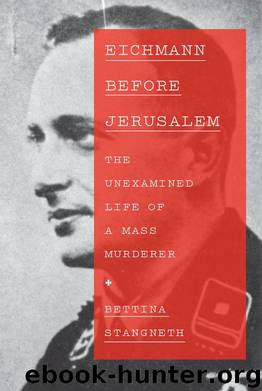Eichmann Before Jerusalem: The Unexamined Life of a Mass Murderer by Stangneth Bettina

Author:Stangneth, Bettina [Stangneth, Bettina]
Language: eng
Format: azw3, epub
ISBN: 9780307959683
Publisher: Knopf Doubleday Publishing Group
Published: 2014-09-01T16:00:00+00:00
In Argentina in 1957, Eichmann and Alvensleben were bound by more than just a shared admiration for Heinrich Himmler. As they fled Germany, they had both used identity papers produced in the same South Tyrol commune. Three prominent Nazis had traveled on papers issued in Termeno: Josef Mengele, with papers from April 1948; Alvensleben (May 1948); and Eichmann (June 1948). We are a long way from knowing everything about Alvensleben’s escape, but what we do know is surprising and reveals a great deal about the way this route was organized. I am able to tell at least a small part of this complex story following a lunch I had with the Argentine journalist and historian Uki Goñi. I told him about the Alvensleben discussion, and he confided to me his suspicion that Alvensleben had used a Red Cross passport in the name of “Kremhart.” The Austrian historian Gerald Steinacher had searched in vain for Kremhart’s true identity.258 Over the following weeks, meticulous comparisons of handwriting and photographs proved Goñi’s suspicion to be correct.
Alvensleben’s escape began with a letter sent from Lübeck, in northern Germany. On November 30, 1946, a “Lona Kremhart” wrote to the police in Bozen, asking about her husband, “Theodor Kremhart,” whose name might also be written “Kreinhart.”259 He had been born in Posen (Poznań) on September 18, 1905. The last information she had received about him came from Innsbruck. And they had three children. The answer to this slightly odd letter came promptly: Kremhart had been in Bozen since September 1946, in the Zwölfmalgreien guesthouse. A closer look at Frau Kremhart’s handwriting reveals something astonishing: it belonged, without a shadow of a doubt, to Ludolf von Alvensleben.260 Following a spell in a prisoner of war camp in Neuengamme, he had managed to escape on September 11, 1946 (according to Karl Wolff). Early on, he was suspected to be hiding in the north. Alvensleben had family in Lübeck, so it’s no surprise that he wrote from there to Bozen, the town in South Tyrol where Eichmann would collect his new papers. But why was he posing as a woman, asking about two spellings of a name, and saying he had three children? The answer seems to be that this man was looking for a new identity and wanted to leave Europe with three children.261 The fact that a letter to a South Tyrolean authority helped him achieve this identity still comes as a surprise, even to people who have spent years researching National Socialist escape routes. But the application form for Theodor Kremhart’s Red Cross passport still has a photo of Ludolf von Alvensleben attached to it. And to cap it all, the applicant’s signature is incredibly similar to that of Lona from Lübeck.262 The Red Cross records show that he presented an identity card issued in Termeno in May 1948 and that his application was supported, like Eichmann’s, by the Catholic priest Edoardo Dömöter, proving that this would-be escapee received preferential treatment.263 “Kremhart” was planning to travel
Download
Eichmann Before Jerusalem: The Unexamined Life of a Mass Murderer by Stangneth Bettina.epub
This site does not store any files on its server. We only index and link to content provided by other sites. Please contact the content providers to delete copyright contents if any and email us, we'll remove relevant links or contents immediately.
| France | Germany |
| Great Britain | Greece |
| Italy | Rome |
| Russia | Spain & Portugal |
Fanny Burney by Claire Harman(26531)
Empire of the Sikhs by Patwant Singh(22983)
Out of India by Michael Foss(16793)
Leonardo da Vinci by Walter Isaacson(13190)
Small Great Things by Jodi Picoult(7025)
The Six Wives Of Henry VIII (WOMEN IN HISTORY) by Fraser Antonia(5402)
The Wind in My Hair by Masih Alinejad(5036)
A Higher Loyalty: Truth, Lies, and Leadership by James Comey(4852)
The Lonely City by Olivia Laing(4752)
The Crown by Robert Lacey(4732)
Millionaire: The Philanderer, Gambler, and Duelist Who Invented Modern Finance by Janet Gleeson(4386)
The Iron Duke by The Iron Duke(4295)
Papillon (English) by Henri Charrière(4200)
Sticky Fingers by Joe Hagan(4106)
Joan of Arc by Mary Gordon(4024)
Alive: The Story of the Andes Survivors by Piers Paul Read(3970)
Stalin by Stephen Kotkin(3885)
Aleister Crowley: The Biography by Tobias Churton(3589)
Ants Among Elephants by Sujatha Gidla(3418)
